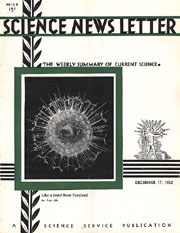From the December 17 & 24, 1932, issues


BEAUTY FROZEN IN GLASS SERVES CAUSE OF SCIENCE
Gems as fantastically beautiful as any that have ever glittered in dreams of a frosty Christmas fairyland are being made in glass for the American Museum of Natural History by Herman Mueller, reputed to be the world’s most skillful glassblower. They are not mere conventional designs, however, nor are they portrayals of imaginary creatures. They are enlargements, on a vast scale, of the strange and often delicately beautiful microscopic plants and animals that swarm unnoticed in the world of waters.
Mr. Mueller was once a glassblower for Tiffany’s, but as medieval and renaissance artists often reserved their best efforts for the service of the Church, so he has withdrawn his labors from the service of fashion to dedicate them to the advancement of popular knowledge of science.
COSMIC RAYS ARE PHOTONS, DR. MILLIKAN DECLARES
Cosmic rays are primarily light rays, or photons, which may be mixed to some extent with secondary charged particles, even when they enter the atmosphere. The rays originate out in interstellar space. These were the conclusions of a discussion of cosmic rays presented at the Mt. Wilson Observatory by Dr. R.A. Millikan, based on results made possible by recent advances in experimental technique developed at the California Institute of Technology.
INTOXICATING DRINK CANNOT BE SCIENTIFICALLY DEFINED NOW
Legislators seeking a definition of an intoxicating beverage will find that science cannot give them one at present. Drunkenness is a gradually developing condition. It would be arbitrary to draw a line at any point and say, “Here intoxication begins.” For a tightrope walker it might be one thing, for an automobile driver another, and for a peaceful pedestrian still another.
Common sense and experience must be used to determine practically what alcoholic beverages should be designated as intoxicating.
These are the opinions of Dr. W.H. Howell, chairman of the National Research Council and formerly director of the Johns Hopkins School of Hygiene and Public Health.
TWIG’S GROWTH SHOWN BY HUGE AUTOMATIC MODEL
Visitors at the science exhibits of the Century of Progress Exposition in Chicago next year will have an opportunity to see in a minute and a quarter how the twig of a tree puts on a year’s growth. A huge model, 7 feet 3 inches in diameter, is now being constructed to represent an enlarged cross-section of a basswood or linden twig a quarter of an inch through. It will be so arranged that when a motor drive is started, it will increase its diameter an additional 18 inches, adding wood on the inside of the growing zone and bark on its outside, in the most realistic manner.
Every microscopic detail of the 3-year-old twig is represented. Each cell of the three annual rings of the wood, with its central pith and the radiating pith rays, is outlined. At the outside, between wood and bark, is the cambium, or growth, layer. It is here that the main action takes place when the motor is started. Outside the cambium is the complex structure usually lumped as “bark,” but detailed here into phloem, or food-conducting strands, parenchyma, or rind, and the true bark. The choice of basswood as the twig to be represented is an especially happy one, because that is the species studied by practically every beginning botany student.
The “growth” of the model is accomplished by means of a series of sliding plates and moving canvasses, which bear the outlines of the new, expanding cells. Each sliding plate is driven by a special worm gear: coarse-pitched gears for the outside “bark” growth, finer-pitched for the inside wood growth. The canvas is wound on rollers, and its unwinding simulates the twig’s growth in diameter. When the motor is started the fourth year’s “growth” is completed in 75 seconds; then the twig is automatically returned to its three-year condition, ready for the next “show.”
ACHIEVEMENTS IN 1932
Important advances were made in every field of science during 1932.
Ten outstanding groups of science achievements may be listed:
1. Discovery of the neutron, extensive research on cosmic rays, and successful attacks on the atomic nucleus.
2. Imminent development of vaccines protective against yellow and typhus fevers and evidence that virus diseases are caused by nonliving chemicals that attach to living matter.
3. Demonstration that tooth decay is caused by inadequate calcium, phosphorus, and vitamin D and further discoveries of the nature of vitamins
4. Continued discovery of hormones, including prolactin, an anterior pituitary principle controlling milk secretion, and a hormone useful in determining sex before birth.
5. Discovery of treasure tombs at Monte Alban, Mexico, exploration of an unknown Mayan city and continued archaeological unearthing of ancient civilizations in the Old World.
6. Increasing evidence for the antiquity of man on the North American continent and new discoveries of ancient man in Eurasia and Africa.
7. The total eclipse of the sun on Aug. 31 and the discovery of the asteroid or minor planet that comes closest to Earth.
8. Launching of the world’s largest ship, the Normandie, and the completion of the Soviet power plant, the Dneprostroy.
9. Research in Arctic meteorology and geophysics was stimulated by the inauguration of the Second Polar Year.
10. Psychological testing methods found increasing industrial use under the stimulus of economic conditions and employment techniques.







